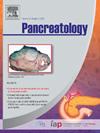迈向导管内乳头状粘液瘤的自动化风险分层:人工智能在共聚焦激光内镜下超越了人类的专业知识。
IF 2.7
2区 医学
Q2 GASTROENTEROLOGY & HEPATOLOGY
引用次数: 0
摘要
背景和目的:超声内镜(EUS)引导下的针基共聚焦激光内镜(nCLE)能够实现胰腺囊肿上皮的实时显微可视化,并能识别支管(BD)导管内乳头状粘液瘤(IPMNs)中的高级别发育不良/浸润性腺癌(HGD/IC)。我们的目的是比较专家(人类)和人工智能(AI)在对BD-IPMNs的发育不良进行分层方面的表现。方法:本事后分析纳入单中心前瞻性EUS-nCLE研究(2015-2023)中明确诊断的BD-IPMNs。发育不良分级由两名病理学家复查。盲法EUS-nCLE专家回顾了未编辑的nCLE视频,在没有和有修订的福冈标准(修订- fc)的情况下对发育不良进行分类。人工智能模型nCLE-AI也进行了类似的分析。比较诊断参数和AUC,以评估人类和nCLE-AI的性能。结果:60例BD-IPMNs(平均大小= 3.43±1.00 cm)中,23例(38.3%)有HGD/IC。为了使用nCLE检测HGD/IC, 16名nCLE专家的观察者间一致性(IOA)是“公平的”(κ = 0.29, 95% CI: 0.27-0.32),灵敏度为58%,特异性为59%,AUC为0.59 (95% CI 0.55-0.62)。纳入修正fc后,灵敏度提高至72%,AUC提高至0.64 (95% CI 0.61-0.68;p < 0.001),具有相似的IOA (κ = 0.36 'fair', 95% CI: 0.33-0.38)和特异性(57%)。相比之下,nCLE-AI的敏感性为87%,特异性为54%,AUC为0.70(0.57-0.84)。当与修正版fc联合使用时,nCLE-AI达到78%的敏感性,78%的特异性,AUC为0.85 (95% CI: 0.74-0.96, p = 0.02),显著高于人类修正版fc (p < 0.01)。结论:使用nCLE对BD-IPMNs进行人类发育不良分类具有中等的IOA和准确性。相比之下,nCLE-AI分类结合临床标准在检测HGD/IC方面提供了更高的准确性,同时消除了观察者之间的差异。本文章由计算机程序翻译,如有差异,请以英文原文为准。
Towards automating risk stratification of intraductal papillary mucinous Neoplasms: Artificial intelligence advances beyond human expertise with confocal laser endomicroscopy
Background and aims
Endoscopic Ultrasound (EUS)-guided needle-based confocal laser endomicroscopy (nCLE) enables real-time microscopic visualization of pancreatic cyst epithelium and can identify high-grade dysplasia/invasive adenocarcinoma (HGD/IC) in branch-duct (BD) intraductal papillary mucinous neoplasms (IPMNs). We aimed to compare the performance of experts (humans) with artificial intelligence (AI) in stratifying dysplasia in BD-IPMNs.
Methods
This post-hoc analysis involved BD-IPMNs with definitive diagnoses from prospective EUS-nCLE studies (2015–2023) enrolled at a single center. Dysplasia grade was reviewed by two pathologists. Blinded EUS-nCLE experts reviewed unedited nCLE videos to classify dysplasia without and with revised Fukuoka criteria (revised-FC). The AI model, nCLE-AI, was similarly analyzed. Diagnostic parameters and AUC were compared to evaluate human and nCLE-AI performance.
Results
Among 60 BD-IPMNs (mean size = 3.43 ± 1.00 cm), 23 (38.3 %) had HGD/IC. To detect HGD/IC using nCLE, interobserver agreement (IOA) among 16 nCLE experts was ‘fair’ (κ = 0.29, 95 % CI: 0.27–0.32), with a sensitivity of 58 %, specificity of 59 %, and AUC of 0.59 (95 % CI 0.55–0.62). Incorporating revised-FC improved the sensitivity to 72 % and AUC to 0.64 (95 % CI 0.61–0.68; p < 0.001), with similar IOA (κ = 0.36 ‘fair’, 95 % CI: 0.33–0.38) and specificity (57 %).
Comparatively, nCLE-AI achieved 87 % sensitivity, 54 % specificity, and an AUC of 0.70 (0.57–0.84). When combined with revised-FC, nCLE-AI reached 78 % sensitivity, 78 % specificity, and an AUC of 0.85 (95 % CI: 0.74–0.96, p = 0.02), significantly higher than humans with revised-FC (p < 0.01).
Conclusions
Human dysplasia classification of BD-IPMNs using nCLE showed modest IOA and accuracy. In contrast, nCLE-AI classifications combined with clinical criteria offer superior accuracy for detecting HGD/IC while eliminating interobserver variability.
求助全文
通过发布文献求助,成功后即可免费获取论文全文。
去求助
来源期刊

Pancreatology
医学-胃肠肝病学
CiteScore
7.20
自引率
5.60%
发文量
194
审稿时长
44 days
期刊介绍:
Pancreatology is the official journal of the International Association of Pancreatology (IAP), the European Pancreatic Club (EPC) and several national societies and study groups around the world. Dedicated to the understanding and treatment of exocrine as well as endocrine pancreatic disease, this multidisciplinary periodical publishes original basic, translational and clinical pancreatic research from a range of fields including gastroenterology, oncology, surgery, pharmacology, cellular and molecular biology as well as endocrinology, immunology and epidemiology. Readers can expect to gain new insights into pancreatic physiology and into the pathogenesis, diagnosis, therapeutic approaches and prognosis of pancreatic diseases. The journal features original articles, case reports, consensus guidelines and topical, cutting edge reviews, thus representing a source of valuable, novel information for clinical and basic researchers alike.
 求助内容:
求助内容: 应助结果提醒方式:
应助结果提醒方式:


